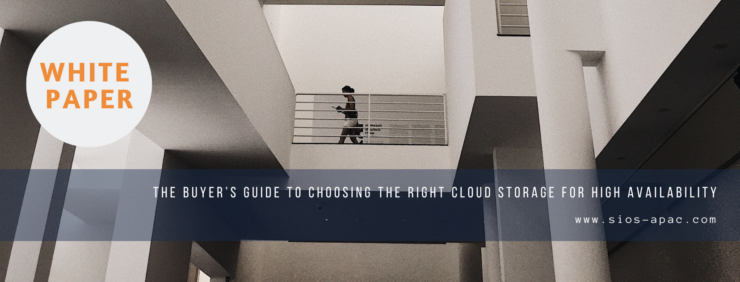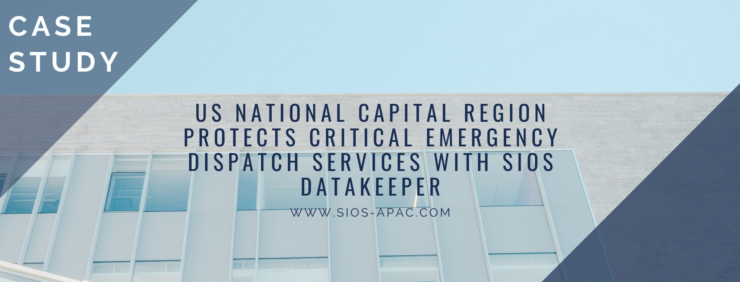Webinar: Empowering Education: Enhancing System Availability with SIOS Solutions
Webinar: Empowering Education: Enhancing System Availability with SIOS Solutions
Register for the On-Demand Webinar
Navigating the challenges of modern education requires more than just innovative teaching methods; it demands robust technological support.
This webinar discusses the pivotal roles of High Availability (HA) and Disaster Recovery (DR) in ensuring uninterrupted learning experiences. Discover how institutions can effectively manage peak seasons, cater to global student demographics, and handle potential system failures. With a special spotlight on SIOS high availability solutions, learn how to build a resilient, cost-effective, and user-friendly IT infrastructure.
Reproduced with permission from SIOS
Creating a SQL Server 2019 Cluster on GCP with SIOS DataKeeper
Creating a SQL Server 2019 Cluster on GCP with SIOS DataKeeper
Create a SQL Server 2019 Cluster on Google Cloud Platform (GCP) with our step-by-step guide. Using SIOS DataKeeper Cluster Edition for SANLess clustering, our guide simplifies the process with pre-scripted steps and builds on Google’s documentation for ease and consistency.
Reproduced with permission from SIOS
White Paper: The Buyer’s Guide to Choosing the Right Cloud Storage for High Availability
White Paper: The Buyer’s Guide to Choosing the Right Cloud Storage for High Availability
High availability is non-negotiable for business essential applications, but with so many cloud storage solutions on the market, how do you choose? This white paper discusses the 10 key questions you should ask before you buy to ensure high availability, seamless disaster recovery, and cost-effective scalability that’s right for you.
Reproduced with permission from SIOS
US National Capital Region Protects Critical Emergency Dispatch Services with SIOS DataKeeper
US National Capital Region Protects Critical Emergency Dispatch Services with SIOS DataKeeper
SIOS DataKeeper Protects Critical CAD-EX CAD2CAD Software on SQL Server in Azure
Until recently, dispatchers used computer-aided dispatch (CAD) systems that presumed the likely whereabouts and availability of units in neighboring jurisdictions, but to request dispatch, they had to call those neighboring agencies on a dedicated phone line to validate actual unit location and availability. This process slowed response times and did not give first responders access to critical incident details that may be available from the dispatching agency.
To improve efficiency, NCR agency leadership and Emerging Digital Concepts (EDC) collaborated to create the Data Exchange Hub (DEH) – a data exchange and functional interoperability platform designed to provide member NCR emergency services agencies with secure access to data and applications. They used the National Information Exchange Model (NIEM) to ensure the interoperability of systems, communications, and procedures.
The DEH has become a national model of efficient regional cooperation in emergency response. Ensuring Efficient Emergency Dispatch Services for National Capital Region SIOS DataKeeper Protects Critical CAD-EX CAD2CAD Software on SQL Server in Azure.
The primary DEH information exchange is the CAD-to-CAD (C2C) Exchange, which enables dispatchers in all NCR DEH agencies to immediately understand front-line resource locations, resource availability, and to share up-to-date information on related incidents in all C2C Exchange connected CAD systems in member jurisdictions.
The NCR DEH C2C Exchange uses a Microsoft SQL Server database operating on Windows Servers and is deployed in the Azure Commercial Cloud. Given the critical nature of these systems, the DEH demanded high-availability data protection for the C2C Exchange platform Failover Clustering without Added Complexity In a traditional Windows high-availability (HA) environment involving a database, two or more database instance nodes are configured in a Windows Server failover cluster with shared storage (typically a SAN).
The database is operational on the primary node with HA failover software monitoring its operation. If an issue is detected, the HA software orchestrates failover of the database operation to the standby, secondary node(s) in the cluster. In the cloud and other environments where shared storage is not available nor cost-effective, replication is used to create a SANless cluster by synchronizing local storage on each of the cluster nodes so that, in the event of a failover, the secondary node can continue to operate with current data.
In the earlier stages of the project, the NCR IT team had deployed the C2C Exchange platform in a number of environments. This included an on-premises Fairfax County data center and subsequently in multiple third-party, national and local hosting provider environments. In these environments, the C2C Exchange database deployment architecture used Microsoft SQL Server Enterprise Edition and Always On Availability Groups.
As the project expanded, the NCR IT team was driven to take advantage of advancing cloud technologies and to deploy the C2C platform to the Azure Commercial Cloud. The Cloud offered the flexibility and service levels needed to manage the C2C platform in a more virtual environment.
The Azure Cloud also allowed the NCR to deploy a more cost-effective, high-availability, database clustering solution to deliver C2C Exchange application data confidently while simultaneously reducing the higher licensing costs associated with SQL Server Enterprise Edition.
The Solution
The NCR DEH C2C Exchange began employing the SIOS DataKeeper Cluster Edition software to create SANless clusters to protect their C2C Exchange data availability in Azure Commercial Cloud. The software runs on a two-node active-passive Windows Server Failover cluster configuration utilizing SQL Server Standard Edition with Always On Failover Clustering.
The SIOS DataKeeper software uses bandwidth-efficient, host-based, block-level replication to synchronize local storage on all database cluster nodes. If an application availability issue is detected, operation is automatically moved to the secondary node with no manual intervention required. The service levels guaranteed by cloud vendors ensure hardware operability but they do not include software and networking-related causes of application downtime.
The Results
The NCR DEH C2C Exchange has been using the SIOS DataKeeper Cluster Edition software in the Azure Commercial Cloud for more than two years. Participation in the interoperability program has grown. In addition to the initial members, the program now includes the Metro Washington Airports Authority (MWAA), Virginia Counties of Loudoun and Prince William, and Maryland Counties of Montgomery and Prince George’s. The C2C Exchange manages a few thousand shared units and shares data on hundreds of thousands of incidents per year between these participants.
Establishing the high-availability database cluster in the Cloud was fast and straightforward using SIOS DataKeeper Cluster Edition. “We simply installed SIOS DataKeeper to our Windows Server Failover Cluster nodes, configured the local node storage as SIOS managed storage for replication, and it operated seamlessly,” said Greg Crider, EDC Chief Technical Officer and Co-Founder. “An added benefit of the SIOS DataKeeper clustering software is that it enables us to perform regular, rolling software maintenance on the database by transitioning cluster nodes, on-demand, without the need for planned downtime or interruption of service.”
Since implementing SIOS DataKeeper in the NCR C2C Exchange, there have been no downtime issues involving the database or data loss between nodes. Chris Wiseman, EDC President, CEO, and Co-Founder adds, “There have been a few unexpected, uncontrollable networking issues, however, the database failed over quickly and C2C Exchange operation has continued without end users being impacted by prolonged reduction in service. The SIOS DataKeeper software enables us to deliver higher levels of data protection and delivery without needing the more costly SQL Server Enterprise Edition licensing. That adds up to significant, continuing annual savings for our stakeholders.”
The NCR C2C Exchange with SIOS DataKeeper protection is featured by the DHS/SAFECOM in a video link). It was recently put to the tested when three large fires occurred simultaneously at a bank, an apartment complex and a nursing home. The interoperability between CAD systems played a critical role in ensuring fast, efficient response to these incidents.
EDC is broadening C2C Exchange adoption around the United States in other markets with its commercially available NG-CAD-X C2C Exchange product. This functionally advanced C2C offering is being implemented by the City of Denver North Central All-Hazards Region and by greater Southeast Florida. NG-CAD-X is message compatible with the NCR C2C Exchange, deployed in the Azure Government Cloud for CJIS-compliance and law enforcement adoption in addition to fire and EMS ESF, and also implements SIOS DataKeeper Cluster Edition into its database architecture for all of the operational and cost-effective reasons highlighted above. “Strategic partnerships play an important role in providing our customers with the best technology solutions in the marketplace. SIOS DataKeeper in an integral part of our system and is a valuable EDC partner.” said Kevin Konczal, Vice President, EDC.
Reproduced with permission from SIOS




